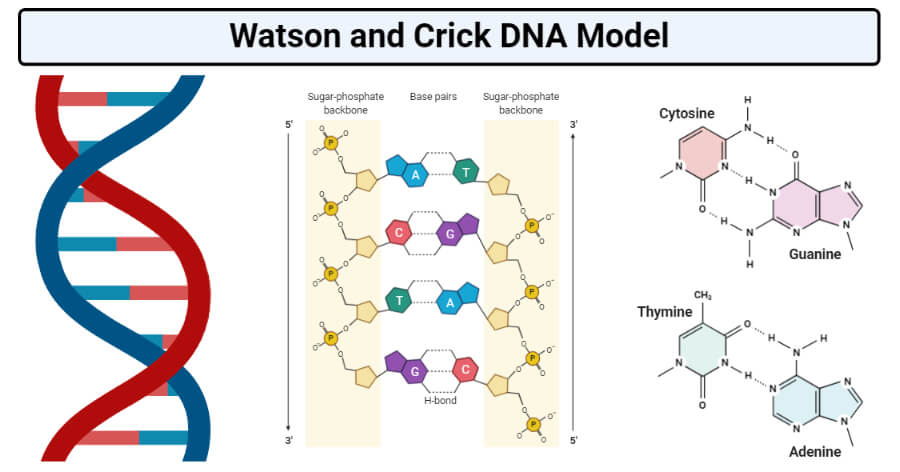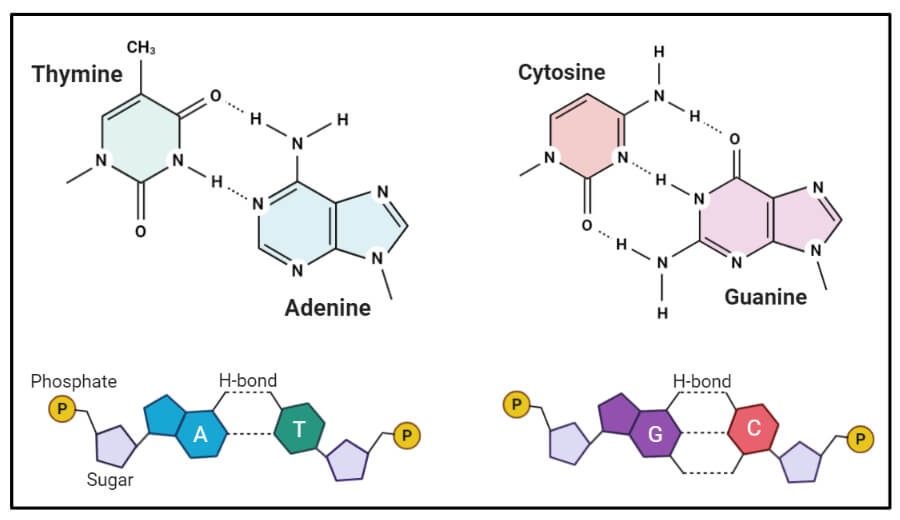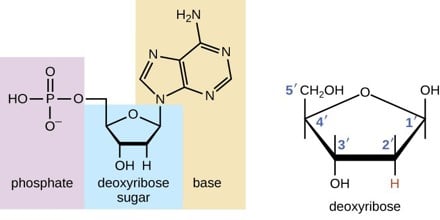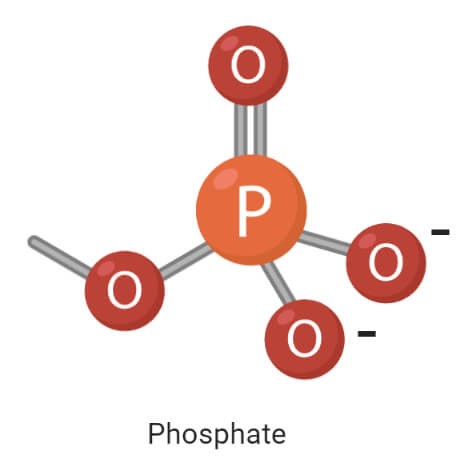DNA stands for Deoxyribonucleic acid, a molecule that contains the instructions an organism needs to develop, live and reproduce. It is a type of nucleic acid and is one of the four major types of macromolecules that are known to be essential for all forms of life.

Interesting Science Videos
DNA Model
- The three-dimensional structure of DNA, first proposed by James D. Watson and Francis H. C. Crick in 1953, consists of two long helical strands that are coiled around a common axis to form a double helix.
- Each DNA molecule is comprised of two biopolymer strands coiling around each other.
- Each strand has a 5′end (with a phosphate group) and a 3′end (with a hydroxyl group).
- The strands are antiparallel, meaning that one strand runs in a 5′to 3′direction, while the other strand runs in a 3′to 5′direction.
- The diameter of the double helix is 2nm and the double-helical structure repeats at an interval of 3.4nm which corresponds to ten base pairs.
- The two strands are held together by hydrogen bonds and are complementary to each other.
- The two DNA strands are called polynucleotides, as they are made of simpler monomer units called nucleotides. Basically, the DNA is composed of deoxyribonucleotides.
- The deoxyribonucleotides are linked together by 3′- 5′phosphodiester bonds.
- The nitrogenous bases that compose the deoxyribonucleotides include adenine, cytosine, thymine, and guanine.
- The structure of DNA -DNA is a double helix structure because it looks like a twisted ladder.
- The sides of the ladder are made of alternating sugar (deoxyribose) and phosphate molecules while the steps of the ladder are made up of a pair of nitrogen bases.
- As a result of the double-helical nature of DNA, the molecule has two asymmetric grooves. One groove is smaller than the other.
- This asymmetry is a result of the geometrical configuration of the bonds between the phosphate, sugar, and base groups that forces the base groups to attach at 120-degree angles instead of 180 degrees.
- The larger groove is called the major groove, occurs when the backbones are far apart; while the smaller one is called the minor groove, and occurs when they are close together.
- Since the major and minor grooves expose the edges of the bases, the grooves can be used to tell the base sequence of a specific DNA molecule.
- The possibility for such recognition is critical since proteins must be able to recognize specific DNA sequences on which to bind in order for the proper functions of the body and cell to be carried out.
Components of DNA Double Helix Structure
The Nitrogen Bases or Nucleotides

- DNA strands are composed of monomers called nucleotides.
- These monomers are often referred to as bases because they contain cyclic organic bases.
- Four different nucleotides, abbreviated A, T, C, and G, (adenine, thymine, cytosine, and guanine) are joined to form a DNA strand, with the base parts projecting inward from the backbone of the strand.
- Two strands bind together via the bases and twist to form a double helix.
- The nitrogen bases have a specific pairing pattern. This pairing pattern occurs because the amount of adenine equals the amount of thymine; the amount of guanine equals the amount of cytosine. The pairs are held together by hydrogen bonds.
- Each DNA double helix thus has a simple construction: wherever one strand has an A, the other strand has a T, and each C is matched with a G.
- The complementary strands are due to the nature of the nitrogenous bases. The base adenine always interacts with thymine (A-T) on the opposite strand via two hydrogen bonds and cytosine always interacts with guanine (C-G) via three hydrogen bonds on the opposite strand.
- The shape of the helix is stabilized by hydrogen bonding and hydrophobic interactions between bases.
Deoxyribose Sugar

- Deoxyribose, also known as D-Deoxyribose and 2-deoxyribose, is a pentose sugar (monosaccharide containing five carbon atoms) that is a key component of the nucleic acid deoxyribonucleic acid (DNA).
- It is derived from the pentose sugar ribose. Deoxyribose has the chemical formula C5H10O4.
- Deoxyribose is the sugar component of DNA, just as ribose serves that role in RNA (ribonucleic acid).
- Alternating with phosphate bases, deoxyribose forms the backbone of the DNA, binding to the nitrogenous bases adenine, thymine, guanine, and cytosine.
- As a component of DNA, which represents the genetic information in all living cells, deoxyribose is critical to life. This ubiquitous sugar reflects a commonality among all living organisms.
The Phosphate Group (Phosphate Backbone)

- The sugar-phosphate backbone forms the structural framework of nucleic acids, including DNA.
- This backbone is composed of alternating sugar and phosphate groups and defines the directionality of the molecule.
- DNA are composed of nucleotides that are linked to one another in a chain by chemical bonds, called ester bonds, between the sugar base of one nucleotide and the phosphate group of the adjacent nucleotide.
- The sugar is the 3′ end, and the phosphate is the 5′ end of each nucleotide.
- The phosphate group attached to the 5′ carbon of the sugar on one nucleotide forms an ester bond with the free hydroxyl on the 3′ carbon of the next nucleotide.
- These bonds are called phosphodiester bonds, and the sugar-phosphate backbone is described as extending, or growing, in the 5′ to 3′ direction when the molecule is synthesized.
- In double-stranded DNA, the molecular double-helix shape is formed by two linear sugar-phosphate backbones that run opposite each other and twist together in a helical shape.
- The sugar-phosphate backbone is negatively charged and hydrophilic, which allows the DNA backbone to form bonds with water.
References
- Alberts, B., Johnson, A., Lewis, J., Raff, M., Roberts, K., & Walter, P. (2002). Molecular biology of the cell. New York: Garland Science.
- http://www.newworldencyclopedia.org/entry/Deoxyribose
- https://www.nature.com/scitable/definition/phosphate-backbone-273
- http://www.newworldencyclopedia.org/entry/Deoxyribose
- https://www.slideshare.net/vinithaunnikrishnan16/forms-of-dna-49312507
- David Hames and Nigel Hooper (2005). Biochemistry. Third ed. Taylor & Francis Group: New York.
- Bailey, W. R., Scott, E. G., Finegold, S. M., & Baron, E. J. (1986). Bailey and Scott’s Diagnostic microbiology. St. Louis: Mosby.

Surely, it was very helpful… thanks alot 🤗👍
I am happy with your notes indeed
Surreal information. Explains the basic information to the best.
It was wonderful
It is very useful for me. Not only that i need it badly. But sir, if you tell me that if I have to write a short note about the watson and crick model of DNA, then what should I do? Are the first row of points are enough?
I like this place.
It’s really useful and easily understandable